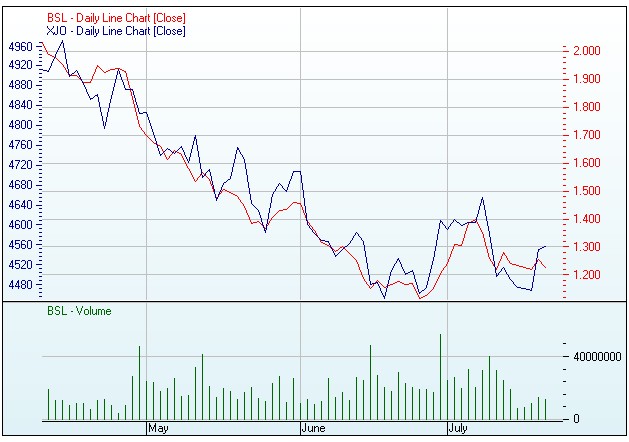The government should immediately refer claims about the leaking of information about its steel industry package to the Australian National Audit Office.
ASIC can get on with an insider trading investigation, but there’s a separate matter for the government as to what prompted the rise in the share prices of both OneSteel and Bluescope in the week before the carbon price announcement.
There are a number of possible explanations, most of them benign. For one thing, neither company noticeably outperformed the market. This chart for Bluescope, the larger company and the bigger recipient of government largesse, suggests its share price did indeed rise significantly, but in line with — actually, slightly lagging — the ASX 200 (the more relevant Metals and Mining index significantly outperformed Bluescope).

The argument thus becomes whether the companies’ prices should have more significantly underperformed the market than they did.
Its also possible that, given the volume of leaking of details of the announcement by the government, and a canny understanding that union pressure on Labor would ensure the steel industry wouldn’t be punished too heavily, fed positive investor sentiment without any specific knowledge of the package. Still, there are rumours that knowledge of the details of the package were known far and wide, and that requires investigation within government.
This is analogous to the “scan scam” in 1998. On 6 May 1998, Health Minister Michael Wooldridge – probably the best Health Minister Australia has had in recent decades – had met with representatives of the Royal Australasian College of Radiologists. On Budget Night, the Howard Government announced on overhaul of diagnostic imaging funding that benefited owners of MRI machines acquired before then. In the four working days between Wooldridge’s meeting and the Budget, 33 MRI machines had been ordered by College members.
After trying to ignore the issue for more than a year, Wooldridge was eventually forced to write to the ANAO to investigate the issue. Its audit expressed frustration that the ANAO couldn’t find a smoking gun, but identified serious deficiencies in the Health Department’s handling of the issue and concluded “on the balance of probabilities, the evidence does at least suggest … an environment where some participants may have deduced, or actually become aware, that the Commonwealth was giving consideration to the inclusion of machines on order in the Budget measure”.
The signal difference is that taxpayers aren’t out of pocket like they were with the flood of MRI machines that enabled radiologists to bill Medicare. But the possible facilitation of of the offence of insider trading is sufficient grounds to ask the ANAO to undertake a review.
Such a review of the circumstances around the final deliberations of the Multi-Party Climate Change Committee and the preparation of the steel package will be more difficult than the MRI audit — the issues involved a lot more officials and ministers compared to a matter that was only between the Health Department and a single College. And there is less clear-cut evidence that any investors “may have deduced, or actually become aware, that the Commonwealth was giving consideration to” any relevant measures.
But the Commonwealth and its officials should be held to a high standard. If it was good enough for the Howard government — hardly a paragon of transparency — to eventually succumb to a review, this one should do so as well, and not wait over a year to do it.








At least in the case of the MRI machines patients had the benefit of an extra 33 machines which in 1998 was probably appreciated.